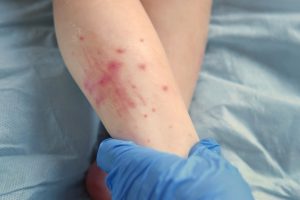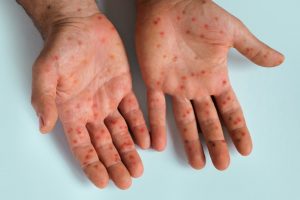The listeriosis outbreak in South Africa is ongoing. As of 29 December 2017, a total of 704 laboratory-confirmed listeriosis cases from all provinces across the country have been reported to NICD since 01 January 2017. Most cases have been reported from Gauteng (61%), Western Cape (13%) and KwaZulu-Natal (7%) provinces. Cases have been diagnosed in both public (66%,) and private (34%,) healthcare sectors, and 61 deaths have been reported so far.
Listeria monocytogenes is a bacterium that occurs widely in nature and is found in agricultural, food processing and retail environments. Listeria may enter the food processing or retail environment from raw materials (food itself) or the movement of people or equipment in processing environments, and can persist due to ineffective cleaning and sanitation.
Sporadic cases and outbreaks of listeriosis have been linked to a wide variety of implicated foods, including unpasteurised and pasteurised dairy products (milk, cheese, butter, ice cream); raw and processed meat and meat products (beef, pork, poultry); seafood (raw and smoked); fresh and frozen produce (several types of vegetables, fruit, and sprouts).
A multisectoral outbreak response team with representatives from the National Department of Health, the Department of Agriculture, Forestry and Fishery (DAFF), the Department of Trade and Industry, the NICD and other relevant stakeholders was tasked by the Minister of Health to coordinate the outbreak response activities. These activities include:
- interviewing patients about foods they ate before falling ill,
- Environmental Health Practitioners visiting homes of persons newly diagnosed with listeriosis and sampling available food where possible, and
- testing L. monocytogenes from patients, foods and the environment to determine if the strains are related.
Listeria from patients, foods and the environment are being tested at the NICD by whole genome sequencing (WGS) to see if the strains are related. WGS determines the bacteria’s complete genetic composition and gives a detailed DNA ‘fingerprint’ to compare strains.
Over 85% of the Listeria from patients tested so far belongs to a single strain (the ST6 strain). This supports the current hypothesis of a single source of food contamination causing the outbreak, i.e. a single widely consumed food product, or multiple food products produced at a single facility.
Environmental Health Practitioners from the City of Tshwane recently investigated a Tshwane patient hospitalised with listeriosis. A chicken sample collected from the fridge at the patient’s home tested positive for L. monocytogenes. This chicken was traced back to the store, and from there traced back to the abattoir it was sourced from. The Environmental Health Practitioners visited the abattoir and collected food and environmental samples, several of which tested positive for L. monocytogenes. As a precaution, the abattoir was closed pending further investigations. The abattoir-related L. monocytogenes are undergoing WGS to assess whether they are related to the ST6 outbreak strain or not; these results will be available in the next week.
At present, the source of the outbreak is not known, so it is uncertain which food/s may be implicated. Cases of listeriosis will continue to be investigated, with trace back and further investigation of any positive food/environmental samples.
To protect against foodborne disease, all South Africans are advised to follow basic food hygiene principles as outlined in the World Health Organization’s ‘Five Keys to Safer Food’ programme:
- Keep clean: wash your hands before handling food and often during food preparation
- Separate raw and cooked: separate raw meat, poultry and seafood from other foods
- Cook thoroughly: cook foods thoroughly, especially meat, poultry, eggs and seafood
- Keep food at safe temperatures: refrigerate and reheat foods correctly
- Use safe water and raw materials: use safe water or make it safe (by boiling); choose foods processed for safety such as pasteurised dairy products; wash fruits and vegetables thoroughly, especially if eaten raw.
The potential risk of listeriosis from chicken
Chicken products have previously been linked to sporadic listeriosis cases and implicated in outbreaks. Listeria is destroyed by cooking, so it is safe to eat chicken that has been properly cooked and steaming hot. However, a cooked chicken product can become contaminated by improper handling or poor sanitary practices in food preparation or storage. This is particularly important with ready-to-eat products (such as sausages/viennas, sliced ‘cold’ meats, polony, smoked chicken, patés) which are usually not reheated before consumption. Also, raw chicken must be handled carefully to prevent cross-contamination, which happens when bacteria that are present on the raw chicken or its juices are spread to other foods (raw or cooked), utensils or kitchen surfaces. Other foods that become contaminated with Listeria in this way may not necessarily be cooked (e.g. lettuce, other vegetables, fruit) and can pose a risk of causing illness.
Guidance for the safe handling and cooking of chicken
- When grocery shopping, keep raw meat, poultry, seafood, and their juices away from other foods.
- Refrigerate chicken bought from supermarkets/butcheries as soon as possible but preferably within 2 hours after leaving the supermarket. Cook the chicken within 2 to 3 days, or freeze it.
- Keep raw meat, poultry, seafood, and eggs separate from all other foods in the fridge.
- Use separate cutting boards and plates for raw meat, poultry, and seafood.
- Cleaning is extremely important to prevent infections from raw chicken as well as other food items. Wash hands well with warm soapy water before and after handling raw chicken. Wash utensils, cutting boards, dishes and counter tops with hot soapy water after preparing each food item and before you prepare the next food item. An easy, effective and cheap way to sanitise food contact surfaces and utensils that have been in contact with raw chicken (e.g. counter tops, cutting boards, knives) is with a freshly made solution of one teaspoon (5 ml) household bleach to 750 ml water.
- Washing chicken or any raw meat is not recommended as the juices may spread or splash to other food items or kitchen surfaces or utensils. Rinsing or soaking chicken does not destroy bacteria.
- Frozen chicken must always be thawed before cooking in the microwave, but can be cooked from frozen in the oven or on the stove.
- Never thaw chicken on the countertop as room temperature encourages bacteria to multiply rapidly. The best method is to place the chicken in a plate that collects all juices and thaw the chicken in the fridge. If chicken has been thawed in the microwave or in cold water, it must be cooked immediately.
- Chicken should be thoroughly cooked at internal temperatures above 74°C; although this is best measured by a food thermometer, most households don’t own one. A good guide is to pierce the thickest part of the meat: it should be thoroughly cooked if the juices run clear and the meat is not too pink inside.
- Cooked chicken should be left to cool at room temperature. Once cool, immediately refrigerate/freeze the chicken. Consume within 2 days if refrigerated.
- Ready-Prepared chicken: when purchasing fully cooked rotisserie or fast food chicken, be sure it is hot at the time of purchase. Use it within 2 hours or cut it into several pieces and refrigerate in shallow, covered containers. Eat within 3 to 4 days, preferably reheated. It is safe to freeze ready-prepared chicken.




